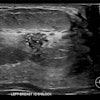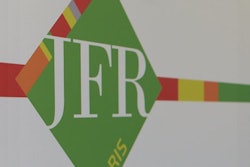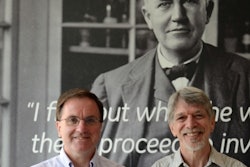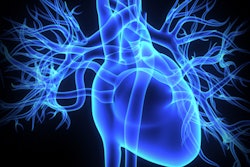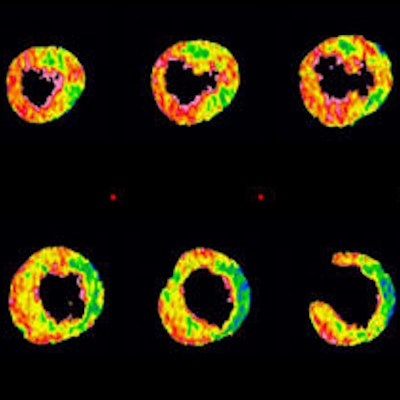
The latest generation dual-source CT (DSCT) scanner cuts the radiation dose of cardiac CT perfusion enough to make it suitable for daily practice, according to new research. Expanded z-axis coverage and better signal-to-noise ratios can offer more information on myocardial blood flow.
A Japanese study presented at ECR 2017 compared image quality and radiation dose when going from second-generation DSCT (Somatom Flash, Siemens Healthineers) with a third-generation system (Somatom Force, Siemens). The group from Mie University Hospital in Tsu examined patients with known or suspected coronary artery disease undergoing stress CT perfusion on the second-generation system and then the third-generation DSCT scanner. Comparing contrast-to-noise ratio and radiation dose between the two, the results showed better enhancement combined with radiation dose reductions of about one-third.
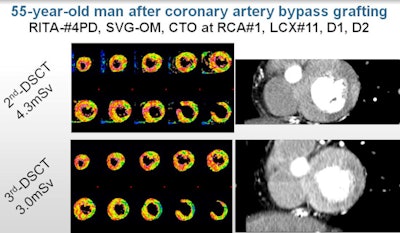 Dynamic perfusion CT of a 55-year-old man after coronary artery bypass grafting. Z-axis coverage of 10.5 cm in the third-generation scanner was sufficient to cover the entire left-ventricular myocardium. Left-ventricular atheroma at myocardium reveals similar perfusion on the anterior and inferior walls, but radiation dose was 30% lower (3.0 mSv) at third-generation DSCT. Images courtesy of Dr. Kakuya Kitagawa, PhD.
Dynamic perfusion CT of a 55-year-old man after coronary artery bypass grafting. Z-axis coverage of 10.5 cm in the third-generation scanner was sufficient to cover the entire left-ventricular myocardium. Left-ventricular atheroma at myocardium reveals similar perfusion on the anterior and inferior walls, but radiation dose was 30% lower (3.0 mSv) at third-generation DSCT. Images courtesy of Dr. Kakuya Kitagawa, PhD.Dose length product per phase and of the entire exam was about 30% lower with the third-generation system than the second-generation scanner, said Dr. Masafumi Takafuji in his ECR talk.
High dose hard to justify
Dynamic CT perfusion (CTP) of the heart offers detailed information on myocardial blood flow in normal and ischemic tissues.
"However, CTP involves multiple acquisitions and is therefore associated with higher radiation," Takafuji said.
But the latest generation of DSCT (Somatom Force) has some notable statistics in its favor, including z-axis coverage in shuttle mode of 10.5 cm, which is 50% more than the second-generation scanner, and covers the entire myocardium in most patients. Even so, increased radiation as a result of increased coverage should be avoided. One way around that limitation is to cut the tube voltage, and a previous phantom study by Meinel and colleagues showed a third-generation scanner can deliver sufficient contrast-to-noise ratio even at 70 kV.
In spite of wider anatomic coverage on the third-generation scanner, "dose reduction may be feasible for CT perfusion," Takafuji said. So, the researchers aimed to evaluate image quality and radiation dose for CT perfusion using third-generation DSCT in comparison with second-generation DSCT.
The retrospective series included 18 patients with known or suspected coronary artery disease who underwent stress CT perfusion of 30 seconds using second-generation DSCT at 80 kV -- and, a couple of years later (mean, 26 ± nine months), repeat CT perfusion scanning on a third-generation machine set at 70 kV. Tube current was determined by automatic exposure control at a quality reference of 350 mAs per rotation at 120 kV for both scans. The study also compared contrast-to-noise ratio (CNR) and dose length product (DLP) between the second- and third-generation scans.
Better enhancement, lower dose
The results showed that dynamic CT perfusion with third-generation DSCT had a 7% higher maximal enhancement but 14% greater noise than the second-generation machine, and no significant differences in the contrast-to-noise ratio. The third-generation scanner also had higher temporal resolution and wider z-axis coverage.
| Second- versus third-generation DSCT scan results | |||
| Parameter | Second-generation DSCT | Third-generation DSCT | P value |
| Maximal enhancement (HU) | 659 ± 124 HU | 734 ± 95 HU | 0.013 |
| Image noise | 17.3 ± 3.0 | 21.2 ± 3.7 | 0.002 |
| CNR | 36.3 ± 9.5 | 33.2 ± 6.7 | 0.189 |
| DLP of entire scan | 314 ± 82 | 226 ± 50 | 0.001 |
| Effective dose (mSv) | 4.4 ± 1.1 mSv | 3.2 ± 0.7 mSv | 0.001 |
| Parameter | Second-generation DSCT | Third-generation DSCT |
| Temporal resolution | 75 ms | 66 ms |
| Number of detector rows | 64 | 66 |
| Z-axis coverage with shuttle mode | 7 cm | 10.5 cm |
"Both DLP per phase and DLP of the entire CTP exam with a third-generation scanner were about 30% lower than the second-generation scanner," Takafuji said. "Third-generation DSCT allows for dynamic CT perfusion with a mean effective dose of 3.2 mSv while maintaining image quality despite wider z-axis coverage."


